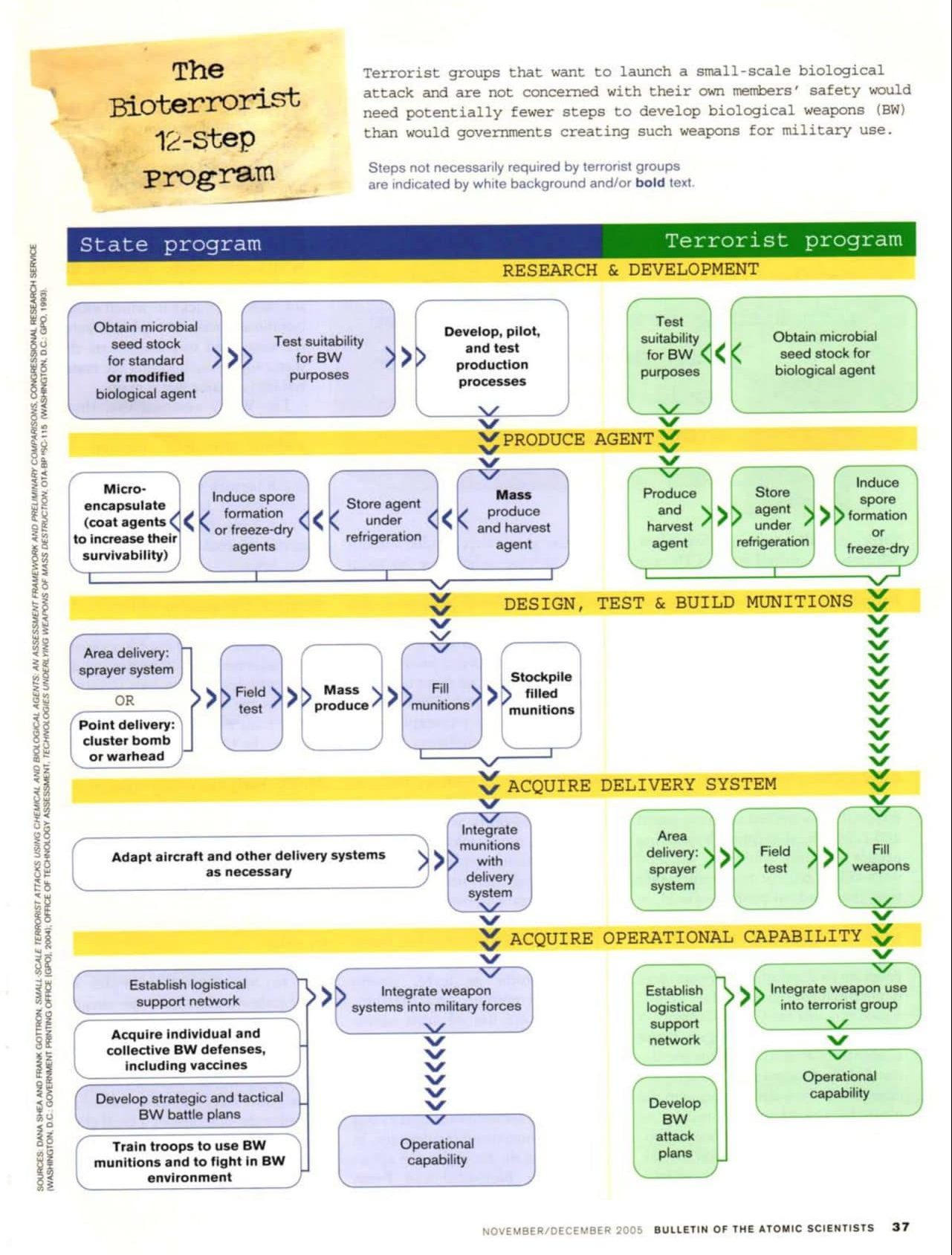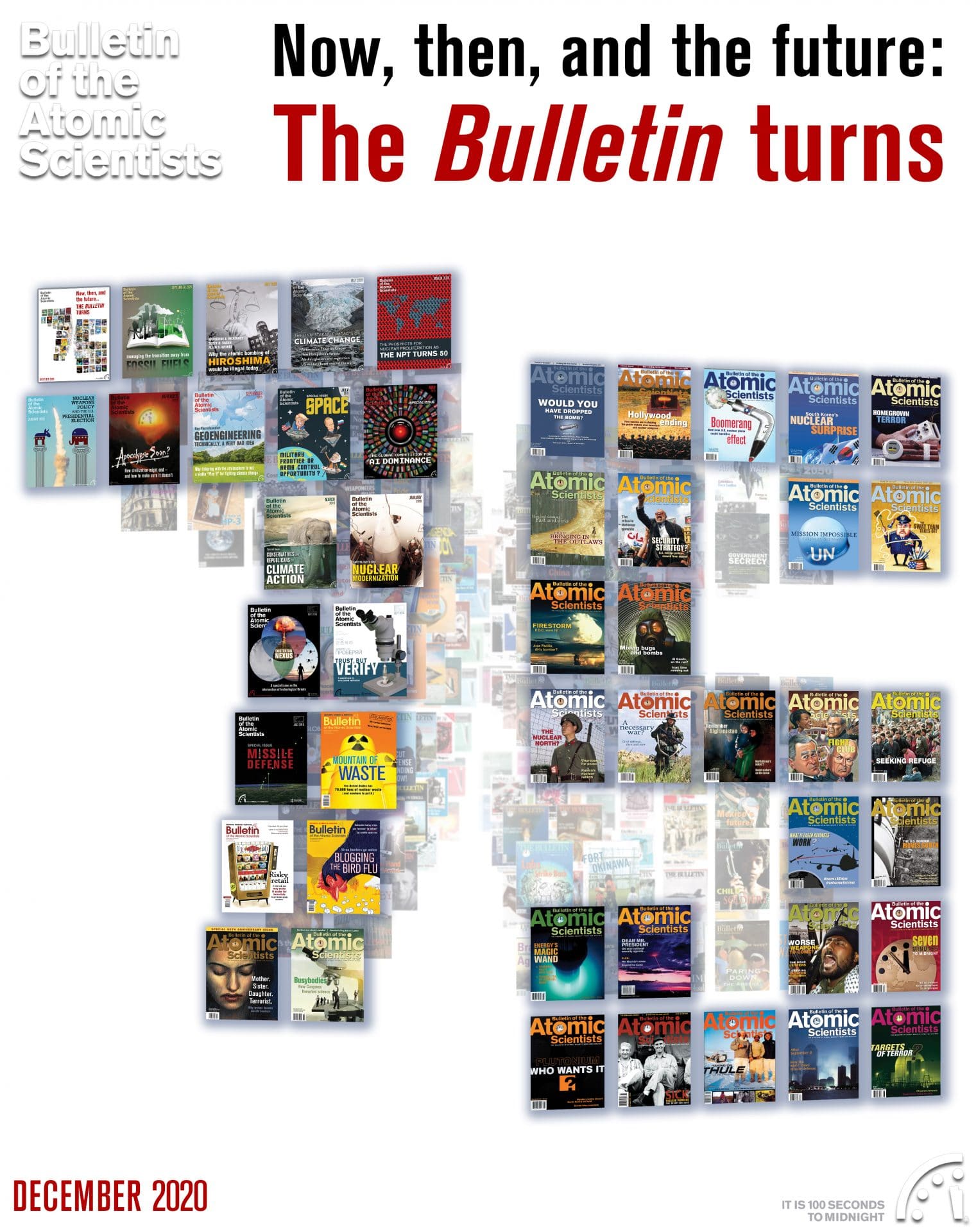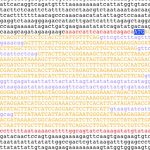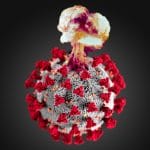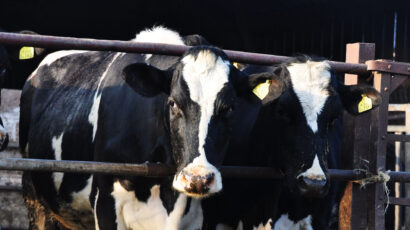2005: The bioterrorist cookbook
By Malcolm Dando, December 7, 2020
Editor’s note: This article was originally published in 2005. It is republished here as part of our special issue commemorating the 75th year of Bulletin publication.
No doubt, Lawrence Wein, a professor of management science at Stanford Business School, did not expect to be at the center of a national controversy over censorship. His research paper, which was slated to be published on May 30, 2005, in the prestigious Proceedings of the National Academy of Sciences (PNAS) , was intended as a thought experiment—a mathematical model of the supply chain providing milk to consumers in the United States and how it might be contaminated by a terrorist using botulinum toxin.[1] The New York Times thought his findings significant enough to invite him to publish an editorial titled “Got Toxic Milk?”[2]
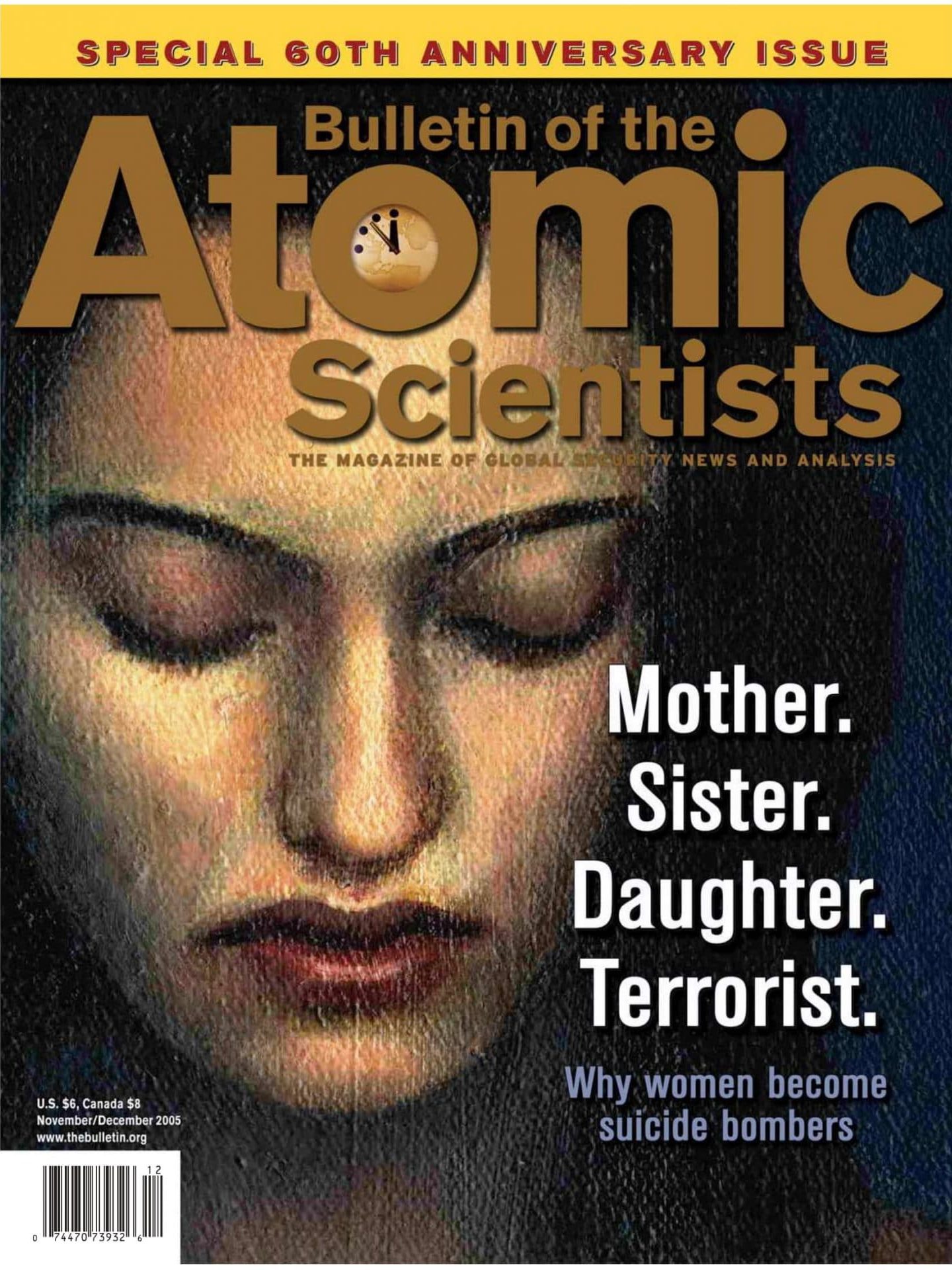
Before publication by PNAS, however, Stewart Simonson, assistant secretary for public health emergency preparedness at the Department of Health and Human Services, wrote to the president of the National Academies, Bruce Alberts, requesting that the paper not be published since it provided a “road map” for terrorists. Simonson’s concerns were not without cause. Botulinum toxin is on the Centers for Disease Control and Prevention’s (CDC) list of highly lethal “Category A” biological agents, along with smallpox, anthrax, plague, tularemia, and viral hemorrhagic fevers. (After the 1991 Gulf War, Iraq admitted to the United Nations that it had produced more than 19,000 liters of concentrated botulinum toxin—theoretically enough to kill tens of millions of people.)
Nevertheless, after due consideration, PNAS published the paper in July 2005. In an explanatory editorial, Alberts argued that “scientific free-for-all in the open literature leads to a refinement of the original findings that will, over time, always make any analyses much more reliable and better understood.”[3]
In that respect, PNAS was quite correct. Wein’s analysis came under immediate and severe criticism from other scientists. Two researchers wrote a rejoinder, published by the Federation of American Scientists, noting that, “Many strains of Clostridium botulinum in nature produce very little or no toxin. Finding the right one in nature out of literally 600 or 700 strains can take a long time.” Looking at all of the variables, they concluded the real chance of successfully carrying out such an attack was only one-billionth of what Wein had stated.[4]
Does this mean we should not be concerned about a bioterrorist attack? Not necessarily. The debate over the botulinum threat is just one vivid example of how we are predominantly looking in the wrong place in attempting to assess the current terrorist threat. Even if terrorists were to find it difficult to execute massive attacks using Category A agents such as botulinum toxin and smallpox, there are other, less exotic biological agents that would be suitable for smaller-scale attacks.
The problem is that our thinking has become dominated by the central concern of terrorists using weapons of mass destruction (WMD) against people. As knowledge from the offensive biological weapons programs undertaken in the twentieth century by the United States, Britain, and the former Soviet Union certainly demonstrated, if the right biological agents are prepared in the right way and used under the right conditions, very large numbers of people could be killed. But biological weapons are not just another type of massive WMD bomb. There are many opportunities for an attacker to wreak havoc that fall short of what one might consider “mass destruction.”[5]
If dozens—as opposed to thousands or millions—of people were killed or made ill, widespread panic would still ensue. And governments would likely respond by spending millions of additional dollars to safeguard the nation and reassure the public. Nor can one assume that the targets of such attacks would be limited to humans. Those state-level offensive programs also carefully investigated the use of bioweapons against agriculture. As anyone living in Britain is aware, the 2001 natural outbreak of foot-and-mouth disease did enormous damage to the country’s farming industry. The infectiousness of the virus—and the fact that it presents little danger to the humans who would handle it—would surely make it appealing to someone wanting to cause great harm.
The A, B, Cs of biowarfare
Economists use the term “barriers to entry” to describe the obstacles confronted by a firm seeking to enter a specific market. Those barriers might include massive up-front research and development costs, or an inadequate infrastructure that precludes small companies from producing mass quantities of goods at affordable prices.
If one were to think of biological weapons as a market, then the barriers to entry could potentially be quite high—that is, assuming an organization sought to develop weapons on a destructive scale comparable to those developed by states for military use. However, a terrorist group aiming for a smaller than WMD-scale attack would have fewer technical obstacles to overcome.
A recent report prepared by the Congressional Research Service (CRS) made precisely this point. In a side-by-side comparison of two hypothetical biological weapons programs—one conducted by a state, the other by a terrorist group—the report demonstrated how the terrorist program would require considerably fewer steps to achieve “operational capability.”[6] (See “The Bioterrorist 12-Step Program” below) A terrorist group, for example, would not need to develop agents that had a long storage life. Nor would it have to optimize the performance of a large-scale dissemination device (specialized munitions or warheads) to deliver the biological agent to its intended target; nor to refine the manufacturing process to produce massive quantities of the agent. Also, a terrorist group would not need to acquire effective individual and collective defenses (including vaccines) for its troops or train them to fight in a biological warfare environment.
Because of such differences, the CRS report notes that “agents that were considered high threats in other frameworks appear to present a lesser threat when viewed in the small scale attack context,” while conversely, “agents that were considered of lesser threat when considering mass casualty attacks may be ranked more highly in the small scale context, as barriers to mass use may be missing when the agent is used on a small scale.” Or, put another way, as the lethality of biological agents declines, so too may the barriers to entry for utilizing some of them as weapons.
The CRS report carries an appendix that gives the relevant characteristics of some 30 agents that are cause for concern. Some of these are on the CDC Category A list, but most are not. For instance, one of these is Salmonella typhimurium, which is categorized by the CDC as a Category B agent (“moderately easy to disseminate,” causing “low mortality rates”). CRS notes that Salmonella typhimurium is common worldwide, causes fever, abdominal pain, diarrhea, and nausea, and that serious complications may occur in a small number of cases. No vaccine exists for this bacterium, and according to the report it could be disseminated by contaminating food or drink.
The opportunities available to a terrorist who wished to cause social and economic disruption by making people ill—and who was satisfied with killing tens or hundreds rather than thousands of people—would, in fact, be rather wide-ranging. Indeed, when the National Institute of Allergy and Infectious Diseases began its program to develop countermeasures to potential biological warfare agents, it used not only the CDC’s Category A list but also a listing of Category B and C agents. (Category C agents are defined as “pathogens that could be engineered for mass dissemination in the future because of availability; ease of production and dissemination; and potential for high morbidity and mortality rates.”) Helpfully, for the nonbiologist, these agents were divided into different groups: inhalation bacteria; arthropod-borne viruses; toxins; food and waterborne pathogens; and emerging infectious diseases.[7]
Although these Category B and C agents were accorded a lower threat priority, a number of them had been weaponized in the twentieth-century state-level offensive bioweapons programs. Thus the inhalation bacteria listed included Coxiella burnetii, the causative agent of Q-fever (fatal to only 1 to 2 percent of those infected); the arthropod-borne viruses included Venezuelan equine encephalitis virus (with a mortality rate of less than 1 percent); and the toxins included Staphylococcal enterotoxin B (which is almost never fatal). The military developed these agents not to kill, but to incapacitate adversaries by inducing such symptoms as fever, violent coughing, vomiting, and diarrhea. The deliberate use of such agents against civilian populations by terrorists might well cause considerable panic.
The potential impact of smaller-scale biological weapons attacks has been well understood for decades. In 1970, during the run-up to the agreement of the Biological and Toxin Weapons Convention (BWC), the World Health Organization (WHO) produced the first edition of its report, Health Aspects of Chemical and Biological Weapons.[8] This study confirmed the possibility that a biological weapon could be used to kill large numbers of people in a WMD-style attack. However, the report also considered examples of sub-WMD attacks in which either botulinum toxin or typhoid bacteria were used to contaminate the water supply by injecting the material into a major water main.
The WHO assumed that these hypothetical attacks took place without any prior warning—so that, if typhoid bacteria were used, the authorities would not begin to see the effects in illness rates until about a week later. The amount of material injected was assumed to be rather limited so that the terrorist did not have an impossible task in producing it. The quantity of water consumed and the percentage of people infected were worked out for a variety of population sizes, climatic conditions, and levels of urban development. In the case of a large, developed, industrial city in a temperate climate, the total number of typhoid cases was calculated to be some 35,000. Early and effective use of antibiotics would reduce the fatalities to about 200. In comparison to other scenarios analyzed by WHO, this outcome was a somewhat best-case scenario. But even so, it would surely have a major impact if such an attack were carried out in a developed country today.
Of course, it is not necessary to resort to hypothetical examples of small-scale attacks, since there already exists detailed information on what might be regarded as a classic case: the 1984 incident in The Dalles, Oregon. There, the followers of cult leader Bhagwan Shree Rajneesh wished to influence the outcome of a local election in their favor by making a large number of the townspeople ill. To this end, on September 11, 1984, the sect began contaminating salad bars in the town with Salmonella typhimurium. On September 17, the public health department began to be notified of people falling ill with gastroenteritis. When it became clear that these victims all reported eating at salad bars, these were closed down on September 25. It was eventually revealed that at least 750 people had been made ill, but the true number affected is likely to have been higher. (There are many outbreaks of food poisoning caused by Salmonella typhimurium each year, and the deliberate nature of this outbreak was not detected at the time.) Only later, in a different investigation, did it become clear that the sect had grown the bacterium—in sufficient quantities to carry out the contamination—in its own laboratories. Fortunately, nobody died as a result of the attack, but there are certainly other more dangerous agents that could have been used.
Bitter pill
Despite the billions of dollars that the United States is spending on biodefense, well-informed critics feel that little real progress has been made. Vaccines and antidotes remain in short supply, local officials have not developed plans to distribute medical supplies in a timely manner to citizens, and hospitals do not have the capacity to handle a sudden surge in patients.[9] Given the plausibility of small-scale biological attacks against not only people (civilian and military), but also livestock, it will become increasingly difficult to mount an effective defense in the coming decades, particularly if the increase and spread of capabilities that the genomics revolution in biology will bring is taken into account. While it is improbable that terrorists today could manipulate an agent for malign purposes—for example, by increasing the antibiotic resistance of an agent—it cannot be ruled out in the decades ahead, in light of the accelerating development of biotechnology worldwide.[10]
Biodefense certainly has a place in what the International Committee of the Red Cross has called a web of prevention. That web is composed of an integrated set of policies centered on the international prohibitionary norm embodied in the 1925 Geneva Protocol and the 1972 BWC, and designed to persuade anyone contemplating the hostile use of modern biology that it is far too costly to attempt. But progress on strengthening the BWC is floundering. At the treaty’s 2001 review conference, the United States, after a decade of multilateral negotiations, rejected outright a proposed verification protocol on the grounds that it would not only be ineffective, but would also put national security and confidential business information at risk.
It is crucial that progress be made lest history repeat itself at the next review conference in 2006. Some modular steps could be taken to fortify the BWC. For example, the confidence-building measures previously agreed upon (including declaration of past activities in offensive and defensive research programs) should be strengthened, and a mechanism put in place to ensure that they are properly submitted by all states parties. Biodefense must be kept in perspective. It certainly cannot be the main solution because there are far too many possibilities for attack.
Together, we make the world safer.
The Bulletin elevates expert voices above the noise. But as an independent nonprofit organization, our operations depend on the support of readers like you. Help us continue to deliver quality journalism that holds leaders accountable. Your support of our work at any level is important. In return, we promise our coverage will be understandable, influential, vigilant, solution-oriented, and fair-minded. Together we can make a difference.
Keywords: anthrax, archive75, biosecurity, bioterrorism, smallpox
Topics: Biosecurity

